26th August, 2025
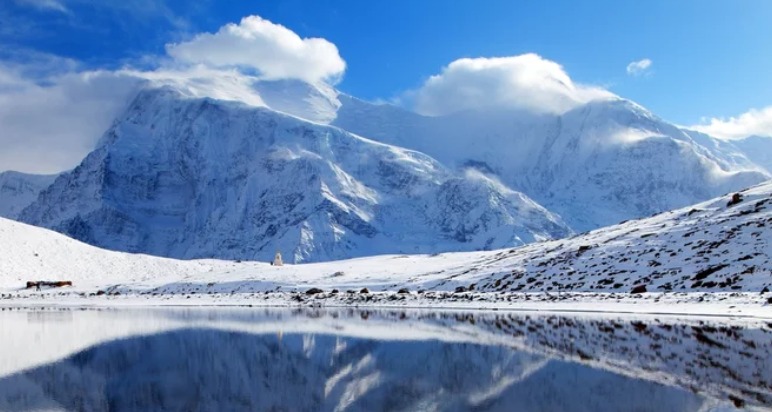
Dec 11, 2023
Annapurna Circuit Trek in November
- How cold does it get on the Annapurna Circuit in November?
- What time of year is best for Annapurna Circuit trek?
- Can you do the Annapurna Circuit in November?
- Which month is best for Annapurna Circuit Trek?
- Annapurna Circuit trek cost
- Highlights of Annapurna Circuit Trek in November
- Challenges of Annapurna Circuit Trek in November
- Is Annapurna Circuit Trek in November Right for Me?
- How to Prepare for the Trek?
- What Permits Do You Need for the Trek?
- What Kind of Food and Accommodation Can You Expect?
- Packing for Annapurna Circuit Trek in November
- Health and Safety
- Some Helpful Tips for Trek in November
- Final Say
- Annapurna Circuit Packages
Trekking the Annapurna Circuit in November offers a captivating adventure amidst Nepal's stunning Himalayan landscapes during the post-monsoon season. November is widely regarded as one of the best months for this trek due to favorable weather conditions and breathtaking scenery.
During November, Nepal experiences clear skies and mild temperatures, making it ideal for trekking. The monsoon rains have subsided, leaving the air crisp and the landscapes lush and green. Daytime temperatures at lower elevations are comfortable for hiking, while nights at higher altitudes can be chilly but manageable with appropriate layers.
One of the highlights of trekking in November is the excellent visibility of the surrounding peaks, including the majestic Annapurna and Dhaulagiri ranges. The crisp autumn air offers stunning panoramic views and vibrant sunrises and sunsets over the snow-capped mountains.

ANNAPURNA ROUND TREK
WORLD-CLASS TREK THROUGH THE (7,629 sq km) Annapurna Conservation Area – the largest in Nepal.The Annapurna Circuit has often been voted as the best long-distance trek in the world!This is a comprehen...
The trekking trails are less crowded compared to the peak season of October, allowing for a more serene and immersive experience in nature. Teahouses along the route are open and welcoming, offering cozy accommodations and hearty meals to replenish energy after a day of trekking.
Culturally, November provides opportunities to witness local life and traditions in the mountain villages along the Annapurna Circuit. Trekkers can interact with friendly locals, visit ancient monasteries, and participate in cultural festivities if coinciding with local holidays.
Overall, trekking the Annapurna Circuit in November promises a rewarding journey filled with natural beauty, cultural encounters, and a sense of accomplishment amidst Nepal's Himalayan splendor. Whether you're a seasoned trekker or embarking on your first Himalayan adventure, November offers an ideal window to explore this iconic trekking route and create lasting memories in the heart of the Himalayas.
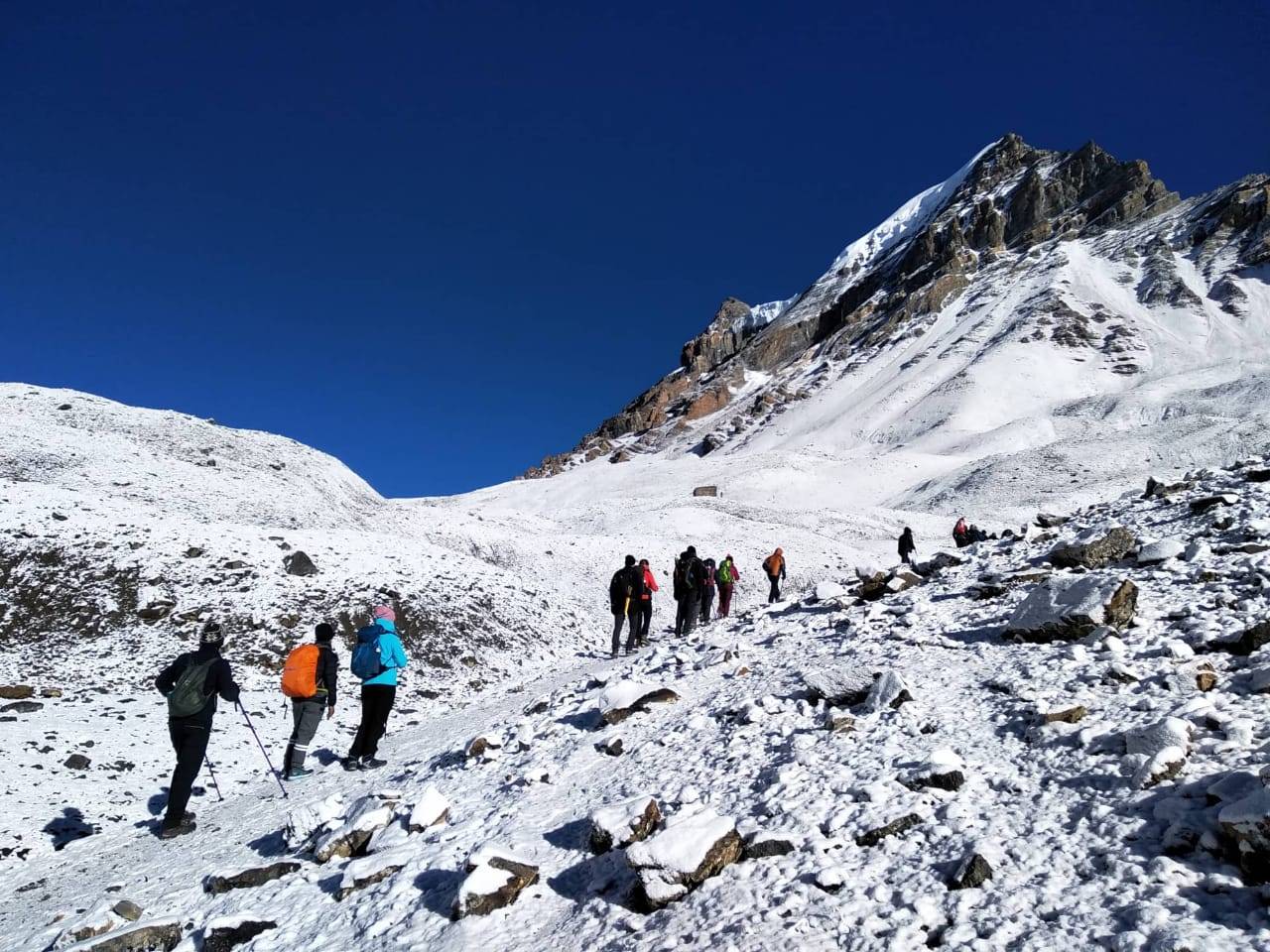
ANNAPURNA CIRCUIT TREK
A LIFE-CHANGING EXPERIENCE – incredible beauty!Circumnavigate the Annapurnas – with one peak at 8091m & 28 peaks over 6000m surrounded by the Kali Gandaki Gorge, Marshyangdi River & Pokhara in...
How cold does it get on the Annapurna Circuit in November?
In November, temperatures along the Annapurna Circuit vary significantly with altitude. During the daytime at lower elevations (around 800 meters), temperatures can range from mild to warm, typically between 15 to 20 degrees Celsius (59 to 68 degrees Fahrenheit). As you ascend higher into the mountains, especially above 3,000 meters, temperatures drop, and nights become chilly. At higher altitudes (above 4,000 meters), nighttime temperatures can fall below freezing, ranging from -5 to -10 degrees Celsius (23 to 14 degrees Fahrenheit). It's essential for trekkers to pack appropriate clothing layers, including a warm jacket, hat, gloves, and thermal base layers, to stay comfortable during colder periods. Despite the cold nights, November is generally a dry month with clear skies, offering spectacular views of the Himalayan peaks.
What time of year is best for Annapurna Circuit trek?
The best time of year to trek the Annapurna Circuit is during the autumn months, particularly from late September to early November. This period follows the monsoon season, offering stable weather conditions with clear skies, mild temperatures, and lush landscapes due to recent rainfall. The autumn weather provides excellent visibility of the Himalayan peaks and comfortable trekking conditions with less risk of rain or snow. Additionally, the autumn months coincide with cultural festivals like Dashain and Tihar, allowing trekkers to experience local traditions and hospitality along the route. The trails are well-maintained, accommodations are open, and the overall trekking environment is vibrant yet not overly crowded, offering a perfect balance of natural beauty and cultural immersion.

14 DAYS ANNAPURNA CIRCUIT TREK
RECOMMENDED WORLDWIDE! VISIT THE HIGHEST PASS & DEEPEST GORGE. An opportunity of a lifetime and adventure seeker’s paradise!The Annapurna Circuit Trek in 14 days with a drive to Chame and Muk...
Can you do the Annapurna Circuit in November?
Yes, trekking the Annapurna Circuit in November is highly recommended due to favorable weather conditions and stunning landscapes. November marks the tail end of Nepal's autumn season, characterized by clear skies, mild daytime temperatures, and cold nights at higher altitudes. The trekking trails are generally less crowded compared to October, offering a more peaceful and immersive experience in nature. Teahouses along the route are open and welcoming, providing comfortable accommodations and hearty meals. Trekkers can enjoy panoramic views of snow-capped peaks, colorful forests, and traditional villages along the Annapurna Circuit. It's important to pack warm clothing layers for colder nights and be prepared for varying weather conditions. With proper preparation and acclimatization, November offers an excellent opportunity to embark on this iconic trekking adventure in the heart of the Himalayas.
Which month is best for Annapurna Circuit Trek?
The best month for trekking the Annapurna Circuit is generally October. This month falls within Nepal's autumn season, immediately following the monsoon rains. October offers stable weather conditions with clear skies, mild temperatures, and lush green landscapes, making it ideal for trekking. The visibility of the Himalayan peaks is excellent, providing stunning panoramic views throughout the trek. Additionally, October coincides with local festivals such as Dashain and Tihar, allowing trekkers to witness cultural celebrations in mountain villages along the route. The trekking trails are well-established and accessible, and teahouses provide comfortable accommodations and hearty meals. October is also popular among trekkers worldwide, creating a vibrant atmosphere on the Annapurna Circuit without being overly crowded. Overall, October combines optimal weather, breathtaking scenery, cultural richness, and comfortable trekking conditions, making it the best month for experiencing the Annapurna Circuit trek in all its splendor.

15 DAYS ANNAPURNA CIRCUIT TREK
A WILD ADVENTURE AMONG SOARING PEAKS - THE DEEPEST VALLEY ON EARTH & EXPOSURE TO UNIQUE CULTURES.THIS TREK HAS IT ALL!The 15 Days Annapurna Circuit Trek is time well spent and will leave you with...
Annapurna Circuit trek cost
The cost of trekking the Annapurna Circuit in November can vary depending on several factors. On average, budgeting between $700 to $1500 USD per person is reasonable, covering permits, accommodation, meals, guides/porters, and miscellaneous expenses. Costs can fluctuate based on accommodation choices (teahouses vs. lodges), whether you hire a guide or porter, and personal spending habits. Permits required include the TIMS (Trekkers' Information Management System) card and the Annapurna Conservation Area Permit (ACAP), totaling around $50 USD. Additional expenses may include travel insurance, equipment rental, tips, and souvenirs. Planning and budgeting in advance ensure a smoother and more enjoyable trekking experience on one of Nepal's most iconic routes.
Highlights of Annapurna Circuit Trek in November
Trekking the Annapurna Circuit in November offers a myriad of highlights amidst Nepal's Himalayan splendor. The post-monsoon season brings clear skies and mild temperatures, ideal for trekking through diverse landscapes. Highlights include panoramic views of Annapurna and Dhaulagiri ranges, lush forests, and picturesque villages. Cultural experiences abound with opportunities to interact with local communities and witness traditional festivals. Teahouses offer warm hospitality and hearty meals, providing a comfortable retreat after days of trekking. November's lesser crowds compared to peak months ensure a serene trekking atmosphere, allowing for a deeper connection with nature. Trekkers can also explore side trips like Tilicho Lake or visit ancient monasteries along the route. Overall, November promises unforgettable moments and stunning vistas, making it a perfect time for adventurers seeking both natural beauty and cultural immersion.
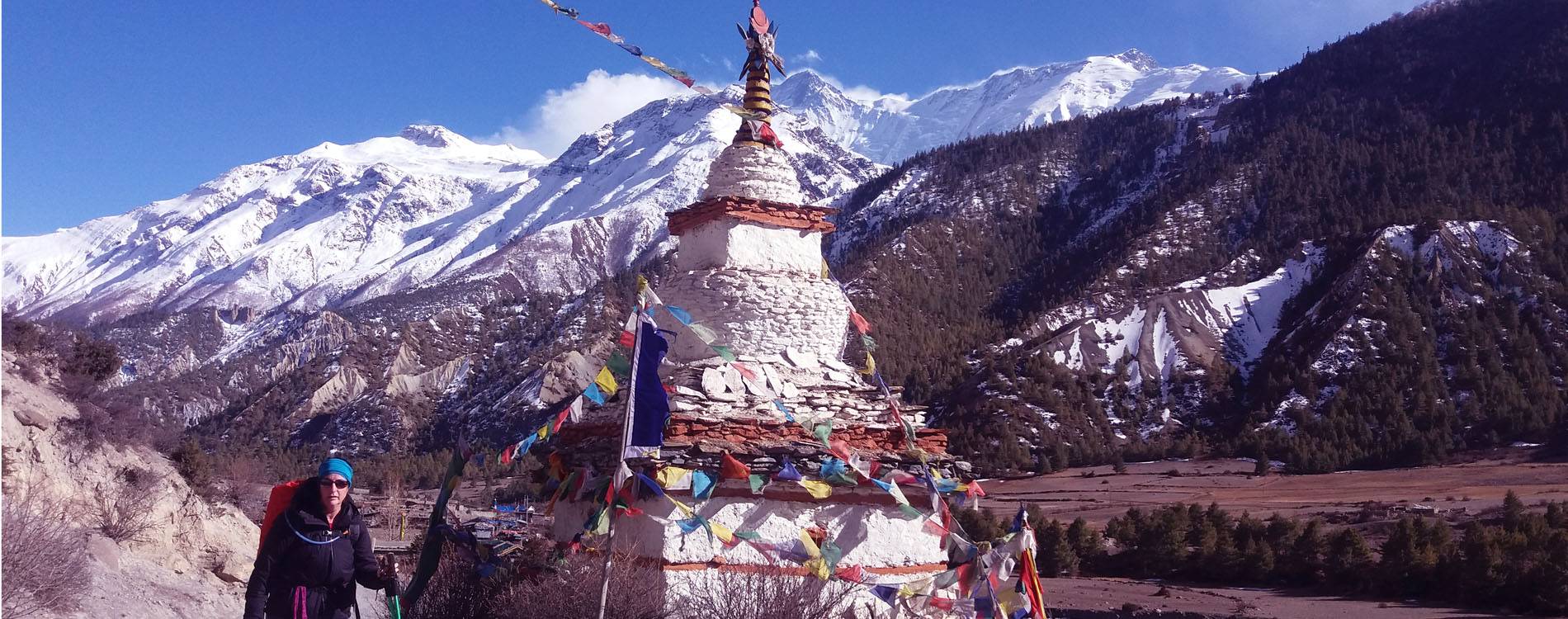
12 DAYS ANNAPURNA CIRCUIT TREK
This classic 12 Days Annapurna Circuit Trek is one of the most popular treks in Nepal. Every year thousands embark on this adventure and return with memories to last a lifetime! On this trek you...
Challenges of Annapurna Circuit Trek in November
Trekking the Annapurna Circuit in November presents certain challenges despite its favorable conditions. While the weather is generally stable, trekkers should prepare for colder temperatures, especially at higher altitudes where nights can drop below freezing. Packing appropriate clothing layers, including a warm jacket, hat, and gloves, is essential. The popularity of the trek during November means that accommodations in teahouses may fill up quickly, requiring advance bookings or flexibility in itinerary planning. Despite the clear skies, trekkers should remain vigilant for sudden weather changes and be prepared for occasional showers towards the end of the month. Altitude sickness remains a risk, necessitating proper acclimatization and hydration throughout the trek. Physical fitness is crucial due to the trek's length and daily elevation gains. By addressing these challenges with thorough preparation and caution, trekkers can maximize their enjoyment and safety on the Annapurna Circuit in November.
Is Annapurna Circuit Trek in November Right for Me?
Deciding if the Annapurna Circuit trek in November is suitable depends on personal preferences and readiness for trekking challenges. November offers ideal weather conditions with clear skies and mild temperatures, making it a popular choice among trekkers. It's suitable for adventurers seeking breathtaking mountain views, cultural experiences in remote villages, and a moderate level of physical challenge. However, trekkers should be prepared for colder nights and potential crowds at popular stops along the route. Physical fitness and stamina are essential due to the trek's length and varying terrain. Cultural enthusiasts can enjoy local festivals and interactions with friendly villagers along the way. If you're ready for a memorable journey amidst Nepal's Himalayan beauty and can manage the logistical and physical demands, then the Annapurna Circuit trek in November could be a perfect fit.
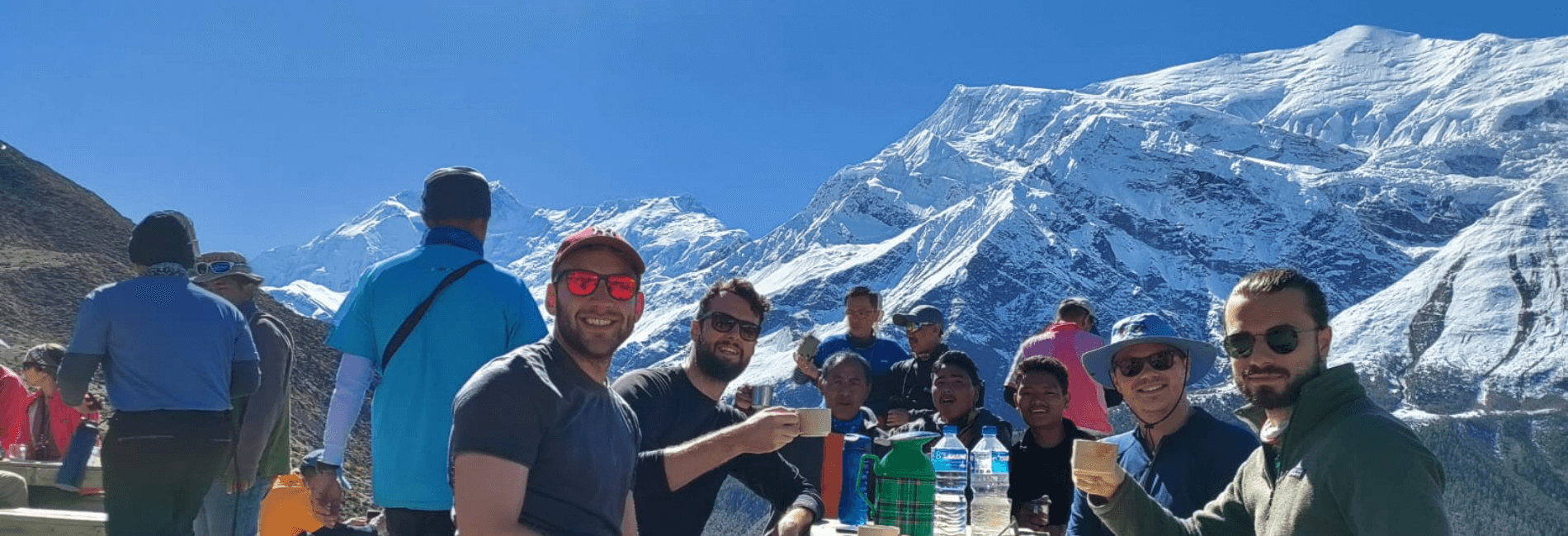
ANNAPURNA CIRCUIT TREK 7 DAYS
The 7 days Annapurna Circuit Trek is, for a good reason, one of the most popular treks in Nepal’s Annapurna Conservation Area where you will witness enormous snow-covered mountains, deep gorges &...
How to Prepare for the Trek?
Preparing for the Annapurna Circuit trek in November requires careful planning and physical readiness:
- Physical Conditioning: Build endurance and strength with cardio exercises and hiking on varied terrain.
- Gear Selection: Pack essential clothing layers for varying temperatures, sturdy trekking boots, a warm sleeping bag, and basic toiletries.
- Altitude Acclimatization: Plan acclimatization days and ascend gradually to prevent altitude sickness.
- Permits and Documentation: Obtain necessary permits like TIMS and ACAP in Kathmandu or Pokhara before starting the trek.
- Training: Familiarize yourself with trekking routes, emergency procedures, and cultural sensitivities. Consider hiring a local guide for added safety and cultural insights.
By preparing meticulously and understanding the trek's challenges, trekkers can enhance their safety and enjoyment on the Annapurna Circuit in November.
What Permits Do You Need for the Trek?
For trekking the Annapurna Circuit, several permits are required:
- TIMS Card: The Trekkers' Information Management System (TIMS) card is mandatory for all trekkers and costs approximately $20 USD. It provides essential trekking information and helps ensure safety and security along the route.
- ACAP Permit: The Annapurna Conservation Area Permit (ACAP) is required for entering and trekking within the Annapurna Conservation Area. It costs around $30 USD per person and helps conserve the natural environment and wildlife of the region.
- Additional Permits: If extending the trek to restricted areas like Upper Mustang or Manaslu, additional permits specific to those regions are required. These permits are obtainable through registered trekking agencies or the Nepal Tourism Board.
Trekkers must carry valid identification (passport) and passport-sized photos for obtaining permits. It's advisable to arrange permits in advance through a trekking agency or upon arrival in Kathmandu or Pokhara to ensure a smooth start to the trek.

ANNAPURNA CIRCUIT TREK 8 DAYS
The Annapurna Circuit Trek is, for a good reason, one of the most popular treks in Nepal’s Annapurna Conservation Area where you will witness enormous snow-covered mountains, deep gorges & high al...
What Kind of Food and Accommodation Can You Expect?
Along the Annapurna Circuit in November, trekkers can expect basic yet comfortable accommodations and a variety of food options at teahouses or lodges. Accommodations typically consist of shared rooms with basic amenities such as beds, blankets, and shared bathrooms. Some teahouses may offer private rooms for an additional cost, depending on availability. Heating may be available in common areas, but rooms can be cold at higher altitudes, so a warm sleeping bag is advisable.
Food options at teahouses include local Nepali dishes like dal bhat (rice and lentils), noodles, and soups, which provide essential carbohydrates and proteins for trekkers. Western dishes such as pasta and pancakes are also available at most teahouses. Meals are generally hearty and served in generous portions to replenish energy after a day of trekking. Vegetarian options are plentiful, reflecting local dietary preferences. Trekkers should carry snacks and energy bars for additional sustenance between meals. Overall, while accommodations are basic, they offer a cozy retreat amidst Nepal's breathtaking mountain scenery.
Packing for Annapurna Circuit Trek in November
Packing efficiently and appropriately for the Annapurna Circuit trek in November ensures comfort and safety amidst varying weather conditions. Essential items include:
- Clothing: Layered clothing for varying temperatures, including thermal base layers, fleece jackets, waterproof outer layers, and a warm down jacket for colder nights.
- Footwear: Sturdy and comfortable trekking boots with ankle support, lightweight hiking shoes/sandals for teahouse comfort.
- Gear: Warm sleeping bag (rated for cold temperatures), backpack with rain cover, headlamp/flashlight with extra batteries, trekking poles for stability, sunglasses, and sunscreen.
- Health and Safety: Basic first aid kit (including blister treatment), personal toiletries, water purification tablets/filters, and reusable water bottle.
- Documents: Passport (with Nepal visa), TIMS card (Trekkers' Information Management System), ACAP (Annapurna Conservation Area Permit), and travel insurance covering trekking activities.
By packing light yet essential gear and clothing suited for November conditions, trekkers can enjoy a comfortable and memorable adventure on the Annapurna Circuit.

ANNAPURNA CIRCUIT WITH TILICHO LAKE TREK 10 DAYS
10 Days Annapurna Circuit Trek with Tilicho Lake – Mesmerizing diversified adventurous Hiking trail of Nepal - Annapurna HimalayasThe Annapurna Circuit Trek With Tilicho Lake (4920m) Trek consistently...
Health and Safety
Maintaining health and safety during the Annapurna Circuit trek in November is paramount for a successful journey. Key considerations include:
- Altitude Acclimatization: Ascend gradually and take acclimatization days to prevent altitude sickness. Recognize symptoms such as headache, nausea, and dizziness.
- Hydration and Nutrition: Drink plenty of water and stay hydrated, especially at higher altitudes where dehydration is common. Eat balanced meals to maintain energy levels.
- Weather Awareness: Be prepared for changing weather conditions. Carry waterproof and windproof clothing layers, and be cautious of slippery trails after rainfall.
- Sun Protection: Use sunscreen and wear sunglasses to protect against UV rays at higher altitudes where sunlight is stronger.
- Emergency Preparedness: Familiarize yourself with emergency procedures and evacuation routes. Carry a fully charged phone and emergency contacts.
By prioritizing health, proper acclimatization, and preparedness for potential challenges, trekkers can minimize risks and enjoy a safe and rewarding experience on the Annapurna Circuit in November.
Some Helpful Tips for Trek in November
Trekking the Annapurna Circuit in November offers breathtaking views and pleasant weather conditions, but here are some additional tips for a successful trek:
- Start Early: Begin trekking early in the day to take advantage of clear skies and avoid afternoon showers.
- Stay Hydrated: Drink plenty of water and stay hydrated, especially at higher altitudes where dehydration is common.
- Pack Wisely: Carry essential items like a warm sleeping bag, waterproof clothing, and adequate snacks. Pack light but include items for colder temperatures.
- Respect Local Culture: Embrace local customs and traditions. Learn basic Nepali phrases and greet locals respectfully.
- Enjoy the Journey: Take time to appreciate the stunning landscapes, interact with locals, and capture memorable moments.
By following these tips and preparing adequately, trekkers can make the most of their Annapurna Circuit trek in November, creating lasting memories amidst Nepal's majestic Himalayan scenery.
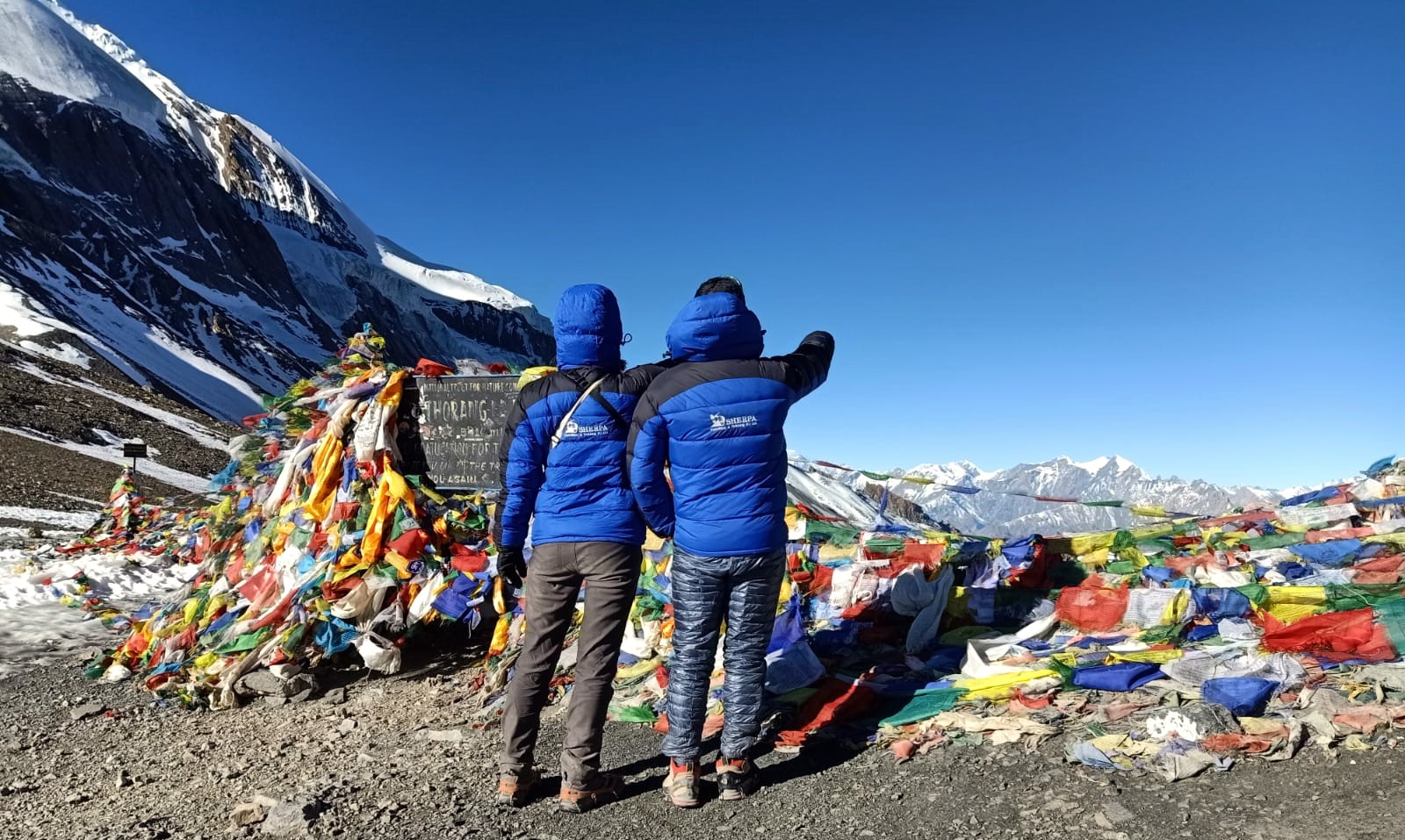
ANNAPURNA CIRCUIT WITH TILICHO LAKE TREK 9 DAYS
Short 9 Days Annapurna Circuit Trek with Tilicho Lake is one of the most impressive and challenging hikes in Nepal. It’s an incredibly popular trekking destination in Nepal and around the world given...
Final Say
Embarking on the Annapurna Circuit trek in November promises an unforgettable adventure amidst Nepal's Himalayan peaks and cultural richness. This iconic trek offers trekkers a blend of natural beauty, from lush forests and cascading waterfalls to panoramic views of snow-capped mountains under clear skies. The weather during November is generally stable, with mild daytime temperatures ideal for trekking, although nights at higher altitudes can be cold.
Accommodations in teahouses provide a cozy retreat after days of exploration, offering hearty meals and warm hospitality. Cultural encounters with local communities along the route add depth to the trekking experience, providing insights into Nepali mountain life and traditions.
Preparation is key to a successful trek, including packing essential gear, acclimatizing properly to higher altitudes, and ensuring health and safety measures are in place. Respecting the environment and local customs enhances the journey's authenticity and impact.
Ultimately, trekking the Annapurna Circuit in November is more than a physical challenge—it's a transformative journey that connects trekkers with nature and culture on a profound level. Whether you're a seasoned adventurer or embarking on your first Himalayan trek, November offers an ideal window to explore one of the world's great trekking routes, leaving you with cherished memories and a renewed appreciation for Nepal's majestic landscapes.
Annapurna Circuit Packages
10 Days Annapurna Circuit Trek
12 Days Annapurna Circuit Trek
14 Days Annapurna Circuit Trek
15 Days Annapurna Circuit Trek
Annapurna Circuit With Tilicho Lake Trek 9 Days
Annapurna Circuit With Tilicho Lake Trek 15 Days

ANNAPURNA CIRCUIT WITH TILICHO LAKE TREK 15 DAYS
This 15-day trek takes you through the Annapurna Conservation Area and to the highest alpine pass in the world – Thorong La Pass (5,416m/17,769ft) and to Tilicho Lake. You will also trek through the d...
Any Questions? Let Us Know.
Recent Posts
17th June, 2025


















